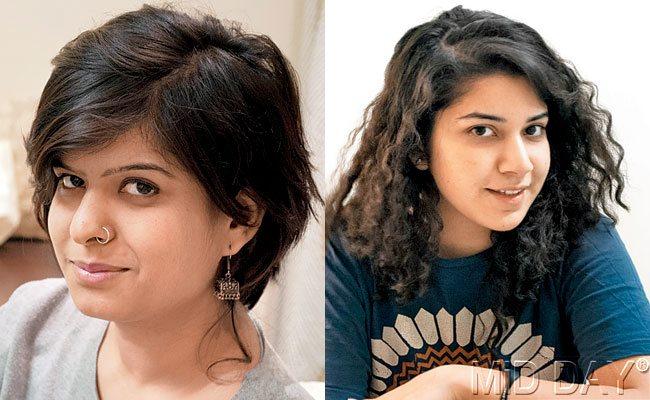Kareena Gianani and Nikshubha Garg speak to 20-something designers who are selling their products through social networks and online shopping sites

Fashion
Sayon, by Sayon Chatterjee
Twenty-five-year-old Sayon Chatterjee always wanted to work with his hands. So pressing was this need that today, for work, he locks himself up in a room at his Delhi home and carves at least three Nagpur-teak spectacle frames in a day and sells them for Rs 4,000-8,000 online.
ADVERTISEMENT

In January this year, he launched Sayon, his eyewear brand, which boasts of frames that are edgy, elegant and earthy. After studying product design at Symbiosis School of Design, Pune, Chatterjee began customising bikes with his brother but soon realised he wasn’t really crafting anything with his own hands. An old conversation with a colleague on wooden frames came flooding back, and Chatterjee decided to explore the idea. “It was a huge risk. No one was making wooden eyewear in India and I didn’t know whether there was a market. There was never a question of having a store or joining someone to learn the craft. I wanted to customise my frames — make art which would start a dialogue, and see what happened,” he says.

Sayon’s eyewear brand boasts of wood frames that are edgy, elegant and earthy. Pics/Kunaal Bose
For six months before he launched the brand, Chatterjee invested time and money in R&D, which included finding the right wood he would use for his frames, branding and marketing to help him run his venture without a brick-and-mortar store. Initially he started an online store, but he couldn’t manage it, and eventually returned to social media for sales. Barely nine months after his launch, he began retailing with Bombay Electric in the city, Misri in Jaisalmer and Jodhpur and LJ Cross in New York.
Chatterjee says he gets orders purely by word-of-mouth and on his Facebook page. Soon after his launch, he exhibited at Delhi and the media coverage by some bloggers greatly boosted his sales. A few weeks later, he kickstarted a giveaway on Facebook which brought more clients to his page by tagging and sharing. He showcased his creations at the Lakme Fashion Week Winter/Festive 2014 last month that helped him bag more collaborations with fashion designers.
“Many entrepreneurs think of a venture in terms of sales. I did not — I wanted to make good art and find people who would appreciate it. Selling online leaves me with the time and money to invest in prototypes which take years in an organisation — I have already designed 15 prototypes till date, and will soon work with maple and rosewood,” he says.
Lola by Suman Bhat
While her peers struggled to find their footing in their careers, 25-year-old Suman Bhat had her priorities in place. “After graduating from Symbiosis Institute of Design, Pune, I decided against taking up a job because you either work towards building someone else’s label or your own. I chose the latter,” she says.

With no one in her family from the field of fashion — her father is an Internet Technologist and software engineer and her mother, an Economics professor — Bhat has come a long way. “I started my label, Lola, two years ago and wanted to learn via trial and error rather than being told what to do,” affirms the entrepreneur.

Suman Bhat’s label focuses on western wear for women which can be customised depending upon the customer’s size
The designer has a design studio in Goa where she invites artists who collaborate with her on collections. “You can be a painter and we could convert your paintings into print or you could be a graphic designer whose graphics could help me create a collection. The aim is to learn from each other,” she says.
She started retailing on her Facebook page last year and admits that social media played a huge role in expanding her venture. “Retailing through social media doesn’t require investment in terms of infrastructure and work force. Also, it suits any start ups business model and helps designers to maintain a personal relationship with the client,” she says.
Lola is a one-man team, but Bhat does not compromise on delivery and transparency. “I’m still in the process of setting up my website. I pack the products myself, use courier services to deliver orders and once I receive the payment, I send a confirmation e-mail to the client,” she says.
So what plans for the future, “For now, I retail on YellowTrunk. I am in talks with websites such as Fashionara and Styletag for displaying my collection there. I’m also going to retail on a multi-designer store soon,” the designer signs off.
Women often have issues about other women wearing similar clothing. To maintain exclusivity, Suman Bhat makes only one piece per design. “I want my garments to be exclusive and the client’s favourite,” she says.
October, by Rabia Singh and Akash Sinha
They neither have a store nor plans of starting one. In fact, October, the Jaipur-based, high-end accessories brand, does not even have a website. Their sales? A couple of hundred bags of all kinds, iPad sleeves, and pockets per month.
It was her year-long internship with a Delhi-based jewellery designer which put Rabia Singh off the idea of taking up a job for good.

The 23-year-old says she was taken aback when, after a year of working for the company, they offered her a job at a salary of Rs 15,000 and told her she would be on probation for the first six months. “I knew my talent and vision were bigger than that, so I decided to start a brand of my own,” she says.

October specialises in durrie and ikat bags
In October last year, Singh and her 23-year-old batchmate at Jaipur’s Pearl Academy, Akash Sinha, founded October, which designs travel accessories made of leather and incorporate durrie, ikat, canvas and eye-catching other materials. The duo works with artisans in Jaipur who use leather and other indigenous textiles.
The entrepreneurs do not have a store anywhere in the country. They sell their products solely through Facebook, online stores (Tadpole Store, Bhane, Indian Roots) and 10 stores across India. Next month, they will begin selling their bags on a US-based website, IndiLust.
“If you don’t have your parent’s name or capital behind you, there is no way two fresh design gradates can open a store and run it along with developing their products and brand name. And, after almost a year, we realise that we don’t even need a store of our own,” says Singh.
Singh and Sinha exploit online avenues to their advantage. They spend the money they make on social media marketing to strengthen their brand identity, experimenting wildly with design and material and being a part of big exhibitions across the country. “We design our bags on a monthly basis as per orders, so there is no money wasted on dead stock. We have rented a place where our eight karigars make bags by hand.
We work out of the same space,” she reveals. Selling on Facebook has helped them save the money on payment gateways, too. All their financial transactions take place via netbanking. Selling on other online shopping websites too is easy, says Singh, because they send consignments and receive cheques.
“In nine months, we have experimented with designs and materials, launched our own clothing line and are approached for tie-ups by stores across the country every day,” says Singh. Next month, October will launch a range of leather bags with Jaipur’s famous blue pottery tiles on them.
The Pot Plant, by Resham Karmchandani and Sanya Suri
The New Delhi-based duo, Resham Karmchandani, 23, and Sanya Suri’s, 22, inclination towards sustainable products gave birth to their label, The Pot Plant. “Sanya was into recycling goods and I always believed in sustainable living. The label was an obvious choice for both of us,” says Karmchandani.

Resham Karmchandani and Sanya Suri
After the two graduated from Pearl Academy, Delhi, Karmchandani took up a job for six months but soon opted out. “Jobs in the fashion industry are thankless and you live someone else’s sensibilities,” she says.

All garments available at The Pot Plant are made up of pure fabrics making them eco-friendly
With social media attracting many start-ups, The Pot Plant was no exception. “Today, no one has the time to go out and shop. However, social media works wonders. A brand’s online presence increases its market value,” she elaborates.
Presently, the brand retails on Facebook and shopping websites such as Tadpole and Curio. “These websites have had good response. Curio displays our collections and gives us a packaged deal whereby they showcase our garments at exhibitions,” smiles Karmchandani.
The duo admits that they always wanted to micromanage a venture and now it has become a reality. Karmchandani says it may sound difficult but it’s relatively easy. “There are freelance designers who can make a website for you at a nominal fee. There are agencies that deliver products on your behalf too and charge Rs 5,000 a month,” she says. Managing a label requires a lot of work and mistakes are the best way to learn. “In the beginning, we spent thousands of rupees sourcing the wrong fabric or were unhappy with the quality. We also faced a lot of marketing problems. But I guess, it’s the love for what you do which makes it worthwhile,” she concludes.
 Subscribe today by clicking the link and stay updated with the latest news!" Click here!
Subscribe today by clicking the link and stay updated with the latest news!" Click here!






